从Java 1.4开始,Java提供了新的非阻塞IO操作API,用意是替代Java IO和Java Networking相关的API。
NIO中有三个核心组件:
Buffer缓冲区
Channel通道
Selector选择器
一、Buffer缓冲区
缓冲区本质上是一个可以写入数据的内存块(类似数组),然后可以再次读取。此内存块包含在NIO Buffer对象中,该对象提供了一组方法,可以更轻松地使用内存块。
相比较直接对数组的操作,BufferAPI更容易操作和管理。
使用Buffer进行数据写入与读取的四个步骤:
将数据写入缓冲区
调用buffer.flip(),转换为读取模式
缓冲区读取数据
调用buffer.clear()或buffer.compact()清除缓冲区
Buffer工作原理
Buffer三个重要属性:
capacity容量:作为一个内存块,Buffer具有一定的固定大小,称为“容量”。
position位置:写入模式时代表写数据的位置。读取模式时代表读取数据的位置。
limit限制:写入模式,限制等于buffer的容量。读取模式下,limit等于写入的数据量。

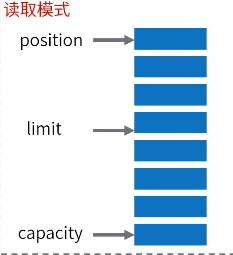

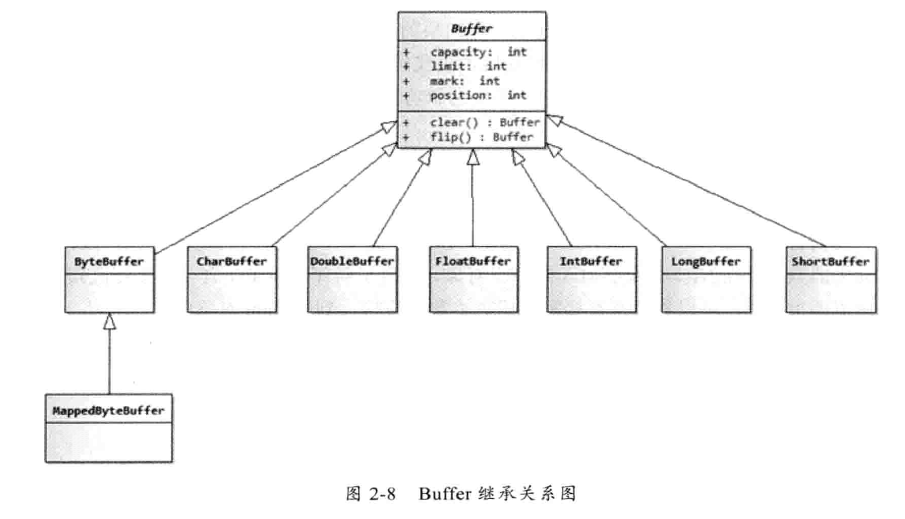
Buffer的API
一个示例
public classBufferDemo {public static voidmain(String[] args) {//构建一个byte字节缓冲区,容量是4
ByteBuffer byteBuffer = ByteBuffer.allocate(4);//默认写入模式,查看三个重要的指标
System.out.println(String.format("初始化:capacity容量:%s, position位置:%s, limit限制:%s", byteBuffer.capacity(),
byteBuffer.position(), byteBuffer.limit()));//写入3字节的数据
byteBuffer.put((byte) 1);
byteBuffer.put((byte) 2);
byteBuffer.put((byte) 3);//再看数据
System.out.println(String.format("写入3字节后,capacity容量:%s, position位置:%s, limit限制:%s", byteBuffer.capacity(),
byteBuffer.position(), byteBuffer.limit()));//转换为读取模式(不调用flip方法,也是可以读取数据的,但是position记录读取的位置不对)
System.out.println("#######开始读取");
byteBuffer.flip();byte a =byteBuffer.get();
System.out.println(a);byte b =byteBuffer.get();
System.out.println(b);
System.out.println(String.format("读取2字节数据后,capacity容量:%s, position位置:%s, limit限制:%s", byteBuffer.capacity(),
byteBuffer.position(), byteBuffer.limit()));//继续写入3字节,此时读模式下,limit=3,position=2.继续写入只能覆盖写入一条数据//clear()方法清除整个缓冲区。compact()方法仅清除已阅读的数据。转为写入模式
byteBuffer.compact(); //buffer内部还残留1个数据,还可以写3个数据
byteBuffer.put((byte) 3);
byteBuffer.put((byte) 4);
byteBuffer.put((byte) 5);
System.out.println(String.format("最终的情况,capacity容量:%s, position位置:%s, limit限制:%s", byteBuffer.capacity(),
byteBuffer.position(), byteBuffer.limit()));//rewind() 重置position为0//mark() 标记position的位置//reset() 重置position为上次mark()标记的位置
}
}
打印的结果:
初始化:capacity容量:4, position位置:0, limit限制:4
写入3字节后,capacity容量:4, position位置:3, limit限制:4
#######开始读取
1
2
读取2字节数据后,capacity容量:4, position位置:2, limit限制:3
最终的情况,capacity容量:4, position位置:4, limit限制:4
从上面可知,与数组相比,数组写入或读取的时候,写到哪,读到哪,我们是不知道的,而buffer则可以方便的知道
ByteBuffer内存类型
ByteBuffer为性能关键型代码提供了直接内存(direct堆外)和非直接内存(heap堆)两种实现。
堆外内存获取的方式:ByteBuffer directByteBuffer=ByteBuffer.allocateDirect(noBytes);
堆内内存生成的是数组
堆外内存的好处:
进行网络IO或者文件IO时比heapBuffer少拷贝一次。(file/socket---OS memory---jvm heap)GC会移动对象内存,在写file或socket的过程中,JVM的实现中,会先把数据复制到堆外,再进行写入。
文件或网络读写的时候,比如java要写一个a,这个a有内存地址1,调用操作系统的api进行写入,写入的过程中把内存地址传递过去,java在操作此写入过程时,会先把数据从堆内存中复制一份到堆外去,复制到内存地址z,再进行写入。因为java中的垃圾回收机制,会移动对象内存,经过这么移动之后,堆内的a的地址很可能就发生了变化,变为地址2,这时候去地址1找a是找不到的。所以为了防止GC的这种后果,在JVM中会先复制一份到堆外。
因此,如果我们直接使用堆外内存,一开始就在堆外申请内存,就会少一次拷贝的过程。因为堆外内存不受GC的管理。GC不管理,堆外内存依然可以回收,下一条正好说的是这件事。
GC范围之外,降低GC压力,但实现了自动管理。DirectByteBuffer中有一个Cleaner对象(PhantomReference,虚引用),Cleaner被GC前会执行clean方法,触发DirectByteBuffer中定义的回收函数Deallocator,清除堆外内存对象所管理的区域。DirectByteBuffer这个对象是受GC管理的,只是申请的内存不管理而已,定义了个方法,在回收DirectByteBuffer对象的时候,触发回收内存的函数。
建议:
性能确实可观的时候才去使用;分配给大型、长寿命;(网络传输、文件读写场景)
通过虚拟机参数MaxDirectMemorySize限制大小,防止耗尽整个机器的内存。堆之外的内存不受GC管理,很多监控工具没法监控。
修改上面代码,堆外缓冲区的写法:
public classDirectBufferDemo {public static voidmain(String[] args) {//构建一个byte字节缓冲区,容量是4
ByteBuffer byteBuffer = ByteBuffer.allocateDirect(4);//默认写入模式,查看三个重要的指标
System.out.println(String.format("初始化:capacity容量:%s, position位置:%s, limit限制:%s", byteBuffer.capacity(),
byteBuffer.position(), byteBuffer.limit()));//写入2字节的数据
byteBuffer.put((byte) 1);
byteBuffer.put((byte) 2);
byteBuffer.put((byte) 3);//再看数据
System.out.println(String.format("写入3字节后,capacity容量:%s, position位置:%s, limit限制:%s", byteBuffer.capacity(),
byteBuffer.position(), byteBuffer.limit()));//转换为读取模式(不调用flip方法,也是可以读取数据的,但是position记录读取的位置不对)
System.out.println("#######开始读取");
byteBuffer.flip();byte a =byteBuffer.get();
System.out.println(a);byte b =byteBuffer.get();
System.out.println(b);
System.out.println(String.format("读取2字节数据后,capacity容量:%s, position位置:%s, limit限制:%s", byteBuffer.capacity(),
byteBuffer.position(), byteBuffer.limit()));//继续写入3字节,此时读模式下,limit=3,position=2.继续写入只能覆盖写入一条数据//clear()方法清除整个缓冲区。compact()方法仅清除已阅读的数据。转为写入模式
byteBuffer.compact();
byteBuffer.put((byte) 3);
byteBuffer.put((byte) 4);
byteBuffer.put((byte) 5);
System.out.println(String.format("最终的情况,capacity容量:%s, position位置:%s, limit限制:%s", byteBuffer.capacity(),
byteBuffer.position(), byteBuffer.limit()));
byteBuffer.array();//rewind() 重置position为0//mark() 标记position的位置//reset() 重置position为上次mark()标记的位置
}
}
二、Channel通道
Buffer是给通道用的

上面是BIO,网络操作通过outputStream和inputStream两个对象来实现的,即Socket和IO的API组合使用,来实现网络数据的交互。需要io包和net包。

而在NIO中,提供了新的API,只需要使用nio包。
提供了channel,channel的API包含了UDP/TCP网络相关的操作和文件IO操作
channel可以同时建立网络连接并传输数据,BIO中需要socket和stream两组API,NIO合二为一
channel:
FileChannel
DataGramChannel
SocketChannel
ServerSocketChannel
和标准IO Stream操作的区别:
在一个通道内进行读取和写入,而stream通常是单向的(input或output)
可以非阻塞读取和写入通道,通道始终读取或写入缓冲区
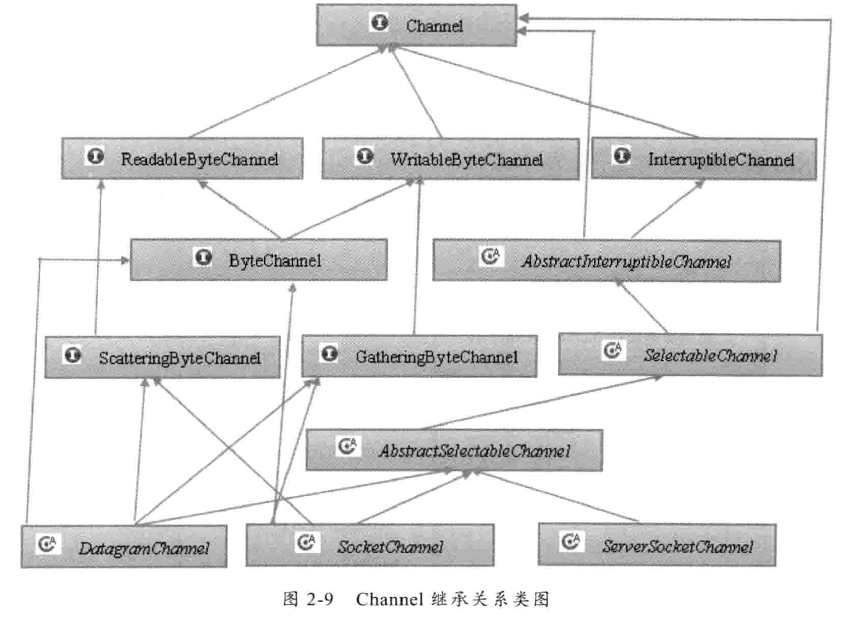
下面介绍API
1.SocketChannel
SocketChannel拥有建立TCP网络连接,类似java.net.Socket。有两种创建socketChannel的形式:
客户端的。客户端主动发起和服务器的连接
服务端的。服务端获取的新连接
//客户端主动发起连接的方式
SocketChannel socketChannel =SocketChannel.open();socketChannel.configureBlocking(false);//设置为非阻塞模式
socketChannel.connect(new InetSocketAddress("http://163.com", 80));
socketChannel.write(buffer);//发送请求数据-向通道写入数据
int bytesRead = socketChannel.read(buffer); //读取服务端返回-读取缓存区的数据
socketChannel.close(); //关闭连接
channel里传入的是Buffer
write写:write()在尚未写入任何内容时就可能返回了。需要在循环中调用write()。
read读:read()方法可能直接返回而根本不读取任何数据,根据返回的int值判断读取了多少字节。
2.ServerSocketChannel
可以建通新建的TCP连接通道,类似ServerSocket。
//创建网络服务端
ServerSocketChannel serverSocketChannel =ServerSocketChannel.open();serverSocketChannel.configureBlocking(false);//设置为非阻塞模式
serverSocketChannel.socket().bind(new InetSocketAddress(8080)); //绑定端口
while (true) {
SocketChannel socketChannel= serverSocketChannel.accept(); //获取新tcp连接通道
if (socketChannl != null) {//tcp请求 读取/响应
}
}
serverSocketChannel.accept():如果该通道处于非阻塞模式,那么如果没有挂起的连接,该方法将立即返回null。必须检查返回的SocketChannel是否为null。
server
/*** 直接基于非阻塞的写法*/
public classNIOServer {public static void main(String[] args) throwsException {//创建网络服务端
ServerSocketChannel serverSocketChannel =ServerSocketChannel.open();
serverSocketChannel.configureBlocking(false); //设置为非阻塞模式
serverSocketChannel.socket().bind(new InetSocketAddress(8080)); //绑定端口
System.out.println("启动成功");while (true) {
SocketChannel socketChannel= serverSocketChannel.accept(); //获取新tcp连接通道//tcp请求 读取/响应
if (socketChannel != null) {
System.out.println("收到新连接 : " +socketChannel.getRemoteAddress());
socketChannel.configureBlocking(false); //默认是阻塞的,一定要设置为非阻塞
try{
ByteBuffer requestBuffer= ByteBuffer.allocate(1024);while (socketChannel.isOpen() && socketChannel.read(requestBuffer) != -1) {//长连接情况下,需要手动判断数据有没有读取结束 (此处做一个简单的判断: 超过0字节就认为请求结束了)
if (requestBuffer.position() > 0)break;
}if (requestBuffer.position() == 0)continue; //如果没数据了, 则不继续后面的处理
requestBuffer.flip();byte[] content = new byte[requestBuffer.limit()];
requestBuffer.get(content);
System.out.println(newString(content));
System.out.println("收到数据,来自:" +socketChannel.getRemoteAddress());//响应结果 200
String response = "HTTP/1.1 200 OK\r\n" + "Content-Length: 11\r\n\r\n" + "Hello World";
ByteBuffer buffer=ByteBuffer.wrap(response.getBytes());while(buffer.hasRemaining()) {
socketChannel.write(buffer);//非阻塞
}
}catch(IOException e) {
e.printStackTrace();
}
}
}//用到了非阻塞的API, 在设计上,和BIO可以有很大的不同.继续改进
}
}
client
public classNIOClient {public static void main(String[] args) throwsException {
SocketChannel socketChannel=SocketChannel.open();
socketChannel.configureBlocking(false);
socketChannel.connect(new InetSocketAddress("127.0.0.1", 8080));while (!socketChannel.finishConnect()) {//没连接上,则一直等待
Thread.yield();
}
Scanner scanner= newScanner(System.in);
System.out.println("请输入:");//发送内容
String msg =scanner.nextLine();
ByteBuffer buffer=ByteBuffer.wrap(msg.getBytes());while(buffer.hasRemaining()) {
socketChannel.write(buffer);
}//读取响应
System.out.println("收到服务端响应:");
ByteBuffer requestBuffer= ByteBuffer.allocate(1024);while (socketChannel.isOpen() && socketChannel.read(requestBuffer) != -1) {//长连接情况下,需要手动判断数据有没有读取结束 (此处做一个简单的判断: 超过0字节就认为请求结束了)
if (requestBuffer.position() > 0)break;
}
requestBuffer.flip();byte[] content = new byte[requestBuffer.limit()];
requestBuffer.get(content);
System.out.println(newString(content));
scanner.close();
socketChannel.close();
}
}
启动两个客户端,只能收到一个新连接

由于server使用while循环不断判断,只有第一个客户端输入后,才能与第二个客户端建立连接,和之前BIO出现了一样的现象,当然BIO那里是因为阻塞,这里是因为while

改进
BIO当时通过多线程进行解决的,我们这里是非阻塞的,没必要使用多线程
升级一
/*** 直接基于非阻塞的写法,一个线程处理轮询所有请求*/
public classNIOServer1 {/*** 已经建立连接的集合*/
private static ArrayList channels = new ArrayList<>();public static void main(String[] args) throwsException {//创建网络服务端
ServerSocketChannel serverSocketChannel =ServerSocketChannel.open();
serverSocketChannel.configureBlocking(false); //设置为非阻塞模式
serverSocketChannel.socket().bind(new InetSocketAddress(8080)); //绑定端口
System.out.println("启动成功");while (true) {
SocketChannel socketChannel= serverSocketChannel.accept(); //获取新tcp连接通道//tcp请求 读取/响应
if (socketChannel != null) {
System.out.println("收到新连接 : " +socketChannel.getRemoteAddress());
socketChannel.configureBlocking(false); //默认是阻塞的,一定要设置为非阻塞
channels.add(socketChannel);
}else{//没有新连接的情况下,就去处理现有连接的数据,处理完的就删除掉
Iterator iterator =channels.iterator();while(iterator.hasNext()) {
SocketChannel ch=iterator.next();try{
ByteBuffer requestBuffer= ByteBuffer.allocate(1024);
// 如果通道里没有数据,就没必要再继续下面的循环读取了if (ch.read(requestBuffer) == 0) {//等于0,代表这个通道没有数据需要处理,那就待会再处理
continue;
}while (ch.isOpen() && ch.read(requestBuffer) != -1) {//长连接情况下,需要手动判断数据有没有读取结束 (此处做一个简单的判断: 超过0字节就认为请求结束了)
if (requestBuffer.position() > 0)break;
}if (requestBuffer.position() == 0)continue; //如果没数据了, 则不继续后面的处理
requestBuffer.flip();byte[] content = new byte[requestBuffer.limit()];
requestBuffer.get(content);
System.out.println(newString(content));
System.out.println("收到数据,来自:" +ch.getRemoteAddress());//响应结果 200
String response = "HTTP/1.1 200 OK\r\n" + "Content-Length: 11\r\n\r\n" + "Hello World";
ByteBuffer buffer=ByteBuffer.wrap(response.getBytes());while(buffer.hasRemaining()) {
ch.write(buffer);
}
iterator.remove();
}catch(IOException e) {
e.printStackTrace();
iterator.remove();
}
}
}
}//用到了非阻塞的API, 再设计上,和BIO可以有很大的不同//问题: 轮询通道的方式,低效,浪费CPU
}
}
三、Selector
循环检查不高效, NIO提供了更好的方法。
多路复用器Selector是一个Java NIO组件,是Java NIO编程的基础。可以检查一个或多个NIO通道,并确定哪些通道已经准备好进行读取或写入。实现单个线程可以管理多个通道,从而管理多个网络连接。
Selector会不断地轮询注册其上的Channel,如果某个Channel上面有新的TCP连接接入、读和写事件,这个Channel就处于就绪状态,会被Selector轮询出来,然后通过SelectorKey可以获取就绪Channel的集合,进行后续I/O操作。

实现一个线程处理多个通道的核心概念理解:事件驱动机制。
不是监听channel
非阻塞的网络通道下,开发者通过Selector注册对于通道感兴趣的事件类型,线程通过监听事件来触发相应的代码执行,比如accept、read、write等事件。(拓展:更底层是操作系统的多路复用机制)
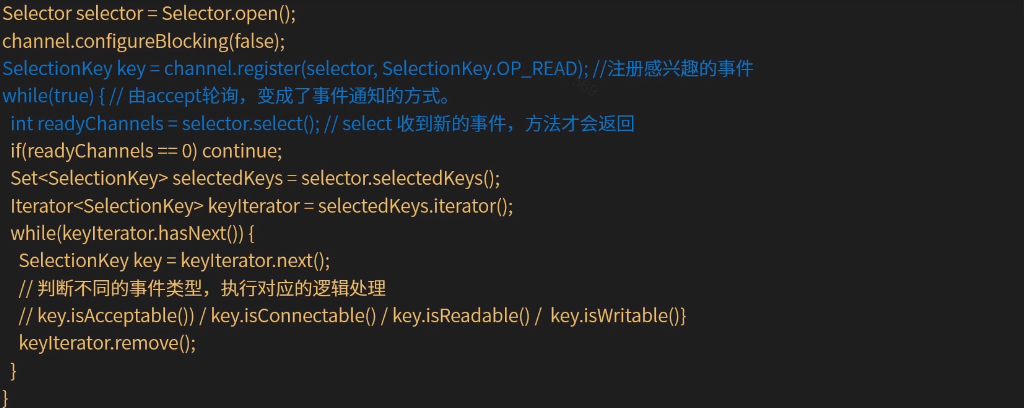
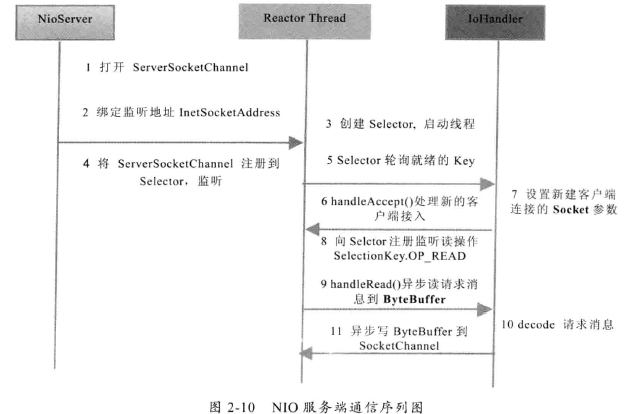
改进二
/*** 结合Selector实现的非阻塞服务端(放弃对channel的轮询,借助消息通知机制)*/
public classNIOServer2 {public static void main(String[] args) throwsException {//1. 创建网络服务端ServerSocketChannel
ServerSocketChannel serverSocketChannel =ServerSocketChannel.open();
serverSocketChannel.configureBlocking(false); //设置为非阻塞模式//2. 构建一个Selector选择器,并且将channel注册上去
Selector selector =Selector.open();
SelectionKey selectionKey= serverSocketChannel.register(selector, 0, serverSocketChannel);//将serverSocketChannel注册到selector
selectionKey.interestOps(SelectionKey.OP_ACCEPT); //对serverSocketChannel上面的accept事件感兴趣(serverSocketChannel只能支持accept操作)//3. 绑定端口
serverSocketChannel.socket().bind(new InetSocketAddress(8080));
System.out.println("启动成功");while (true) {//不再轮询通道,改用下面轮询事件的方式.select方法有阻塞效果,直到有事件通知才会有返回
selector.select();//获取事件
Set selectionKeys =selector.selectedKeys();//遍历查询结果e
Iterator iter =selectionKeys.iterator();while(iter.hasNext()) {//被封装的查询结果
SelectionKey key =iter.next();
iter.remove();//关注 Read 和 Accept两个事件
if(key.isAcceptable()) {
ServerSocketChannel server=(ServerSocketChannel) key.attachment();//将拿到的客户端连接通道,注册到selector上面
SocketChannel clientSocketChannel = server.accept(); //mainReactor 轮询accept
clientSocketChannel.configureBlocking(false);
clientSocketChannel.register(selector, SelectionKey.OP_READ, clientSocketChannel);
System.out.println("收到新连接 : " +clientSocketChannel.getRemoteAddress());
}if(key.isReadable()) {
SocketChannel socketChannel=(SocketChannel) key.attachment();try{
ByteBuffer requestBuffer= ByteBuffer.allocate(1024);while (socketChannel.isOpen() && socketChannel.read(requestBuffer) != -1) {//长连接情况下,需要手动判断数据有没有读取结束 (此处做一个简单的判断: 超过0字节就认为请求结束了)
if (requestBuffer.position() > 0) break;
}if(requestBuffer.position() == 0) continue; //如果没数据了, 则不继续后面的处理
requestBuffer.flip();byte[] content = new byte[requestBuffer.limit()];
requestBuffer.get(content);
System.out.println(newString(content));
System.out.println("收到数据,来自:" +socketChannel.getRemoteAddress());//TODO 业务操作 数据库 接口调用等等//响应结果 200
String response = "HTTP/1.1 200 OK\r\n" +
"Content-Length: 11\r\n\r\n" +
"Hello World";
ByteBuffer buffer=ByteBuffer.wrap(response.getBytes());while(buffer.hasRemaining()) {
socketChannel.write(buffer);
}
}catch(IOException e) {//e.printStackTrace();
key.cancel(); //取消事件订阅
}
}
}
selector.selectNow();
}//问题: 此处一个selector监听所有事件,一个线程处理所有请求事件. 会成为瓶颈! 要有多线程的运用
}
}
NIO对比BIO


如果程序需要支撑大量的连接,使用NIO是最好的方式。
Tomcat8中,已经完全移除了BIO相关的网络处理代码,默认采用NIO进行网络处理。
四、NIO与多线程结合的改进方案
上述的NIO是单线程的,会有性能瓶颈,且无法利用多核的优势。

左:线程池,单Reactor。两种线程,一是Reactor线程,负责网络数据的接收和网络连接的处理。接收的数据进行什么处理,由单独的线程池进行处理。将底层的基础网络处理和应用层的逻辑处理进行了分离,两种线程进行处理。
右:多Reactor。将Reactor分为多种,处理网络连接的有mainReactor去做,处理数据读取由另外的subReactor做,其他和单Reactor相同。
/*** NIO selector 多路复用reactor线程模型*/
public classNIOServerV3 {/**处理业务操作的线程*/
private static ExecutorService workPool =Executors.newCachedThreadPool();/*** 封装了selector.select()等事件轮询的代码*/
abstract class ReactorThread extendsThread {
Selector selector;
LinkedBlockingQueue taskQueue = new LinkedBlockingQueue<>();/*** Selector监听到有事件后,调用这个方法*/
public abstract void handler(SelectableChannel channel) throwsException;private ReactorThread() throwsIOException {
selector=Selector.open();
}volatile boolean running = false;
@Overridepublic voidrun() {//轮询Selector事件
while(running) {try{//执行队列中的任务
Runnable task;while ((task = taskQueue.poll()) != null) {
task.run();
}
selector.select(1000);//获取查询结果
Set selected =selector.selectedKeys();//遍历查询结果
Iterator iter =selected.iterator();while(iter.hasNext()) {//被封装的查询结果
SelectionKey key =iter.next();
iter.remove();int readyOps =key.readyOps();//关注 Read 和 Accept两个事件
if ((readyOps & (SelectionKey.OP_READ | SelectionKey.OP_ACCEPT)) != 0 || readyOps == 0) {try{
SelectableChannel channel=(SelectableChannel) key.attachment();
channel.configureBlocking(false);
handler(channel);if (!channel.isOpen()) {
key.cancel();//如果关闭了,就取消这个KEY的订阅
}
}catch(Exception ex) {
key.cancel();//如果有异常,就取消这个KEY的订阅
}
}
}
selector.selectNow();
}catch(IOException e) {
e.printStackTrace();
}
}
}private SelectionKey register(SelectableChannel channel) throwsException {//为什么register要以任务提交的形式,让reactor线程去处理?//因为线程在执行channel注册到selector的过程中,会和调用selector.select()方法的线程争用同一把锁//而select()方法实在eventLoop中通过while循环调用的,争抢的可能性很高,为了让register能更快的执行,就放到同一个线程来处理
FutureTask futureTask = new FutureTask<>(() -> channel.register(selector, 0, channel));
taskQueue.add(futureTask);returnfutureTask.get();
}private voiddoStart() {if (!running) {
running= true;
start();
}
}
}privateServerSocketChannel serverSocketChannel;//1、创建多个线程 - accept处理reactor线程 (accept线程)
private ReactorThread[] mainReactorThreads = new ReactorThread[1];//2、创建多个线程 - io处理reactor线程 (I/O线程)
private ReactorThread[] subReactorThreads = new ReactorThread[8];/*** 初始化线程组*/
private void newGroup() throwsIOException {//创建IO线程,负责处理客户端连接以后socketChannel的IO读写
for (int i = 0; i < subReactorThreads.length; i++) {
subReactorThreads[i]= newReactorThread() {
@Overridepublic void handler(SelectableChannel channel) throwsIOException {//work线程只负责处理IO处理,不处理accept事件
SocketChannel ch =(SocketChannel) channel;
ByteBuffer requestBuffer= ByteBuffer.allocate(1024);while (ch.isOpen() && ch.read(requestBuffer) != -1) {//长连接情况下,需要手动判断数据有没有读取结束 (此处做一个简单的判断: 超过0字节就认为请求结束了)
if (requestBuffer.position() > 0) break;
}if (requestBuffer.position() == 0) return; //如果没数据了, 则不继续后面的处理
requestBuffer.flip();byte[] content = new byte[requestBuffer.limit()];
requestBuffer.get(content);
System.out.println(newString(content));
System.out.println(Thread.currentThread().getName()+ "收到数据,来自:" +ch.getRemoteAddress());//TODO 业务操作 数据库、接口...
workPool.submit(() ->{
});//响应结果 200
String response = "HTTP/1.1 200 OK\r\n" +
"Content-Length: 11\r\n\r\n" +
"Hello World";
ByteBuffer buffer=ByteBuffer.wrap(response.getBytes());while(buffer.hasRemaining()) {
ch.write(buffer);
}
}
};
}//创建mainReactor线程, 只负责处理serverSocketChannel
for (int i = 0; i < mainReactorThreads.length; i++) {
mainReactorThreads[i]= newReactorThread() {
AtomicInteger incr= new AtomicInteger(0);
@Overridepublic void handler(SelectableChannel channel) throwsException {//只做请求分发,不做具体的数据读取
ServerSocketChannel ch =(ServerSocketChannel) channel;
SocketChannel socketChannel=ch.accept();
socketChannel.configureBlocking(false);//收到连接建立的通知之后,分发给I/O线程继续去读取数据
int index = incr.getAndIncrement() %subReactorThreads.length;
ReactorThread workEventLoop=subReactorThreads[index];
workEventLoop.doStart();
SelectionKey selectionKey=workEventLoop.register(socketChannel);
selectionKey.interestOps(SelectionKey.OP_READ);
System.out.println(Thread.currentThread().getName()+ "收到新连接 : " +socketChannel.getRemoteAddress());
}
};
}
}/*** 初始化channel,并且绑定一个eventLoop线程
*
*@throwsIOException IO异常*/
private void initAndRegister() throwsException {//1、 创建ServerSocketChannel
serverSocketChannel =ServerSocketChannel.open();
serverSocketChannel.configureBlocking(false);//2、 将serverSocketChannel注册到selector
int index = newRandom().nextInt(mainReactorThreads.length);
mainReactorThreads[index].doStart();
SelectionKey selectionKey=mainReactorThreads[index].register(serverSocketChannel);
selectionKey.interestOps(SelectionKey.OP_ACCEPT);
}/*** 绑定端口
*
*@throwsIOException IO异常*/
private void bind() throwsIOException {//1、 正式绑定端口,对外服务
serverSocketChannel.bind(new InetSocketAddress(8080));
System.out.println("启动完成,端口8080");
}public static void main(String[] args) throwsException {
NIOServerV3 nioServerV3= newNIOServerV3();
nioServerV3.newGroup();//1、 创建main和sub两组线程
nioServerV3.initAndRegister(); //2、 创建serverSocketChannel,注册到mainReactor线程上的selector上
nioServerV3.bind(); //3、 为serverSocketChannel绑定端口
}
}





















 1108
1108











 被折叠的 条评论
为什么被折叠?
被折叠的 条评论
为什么被折叠?








